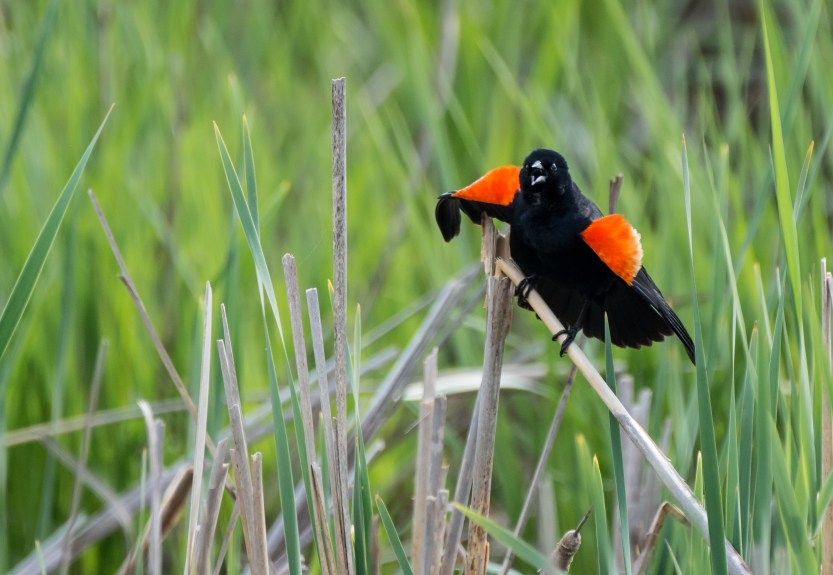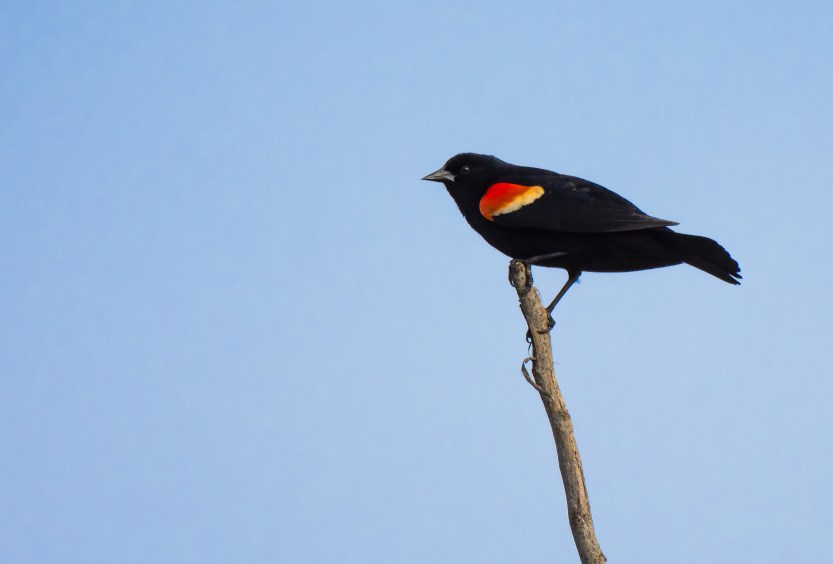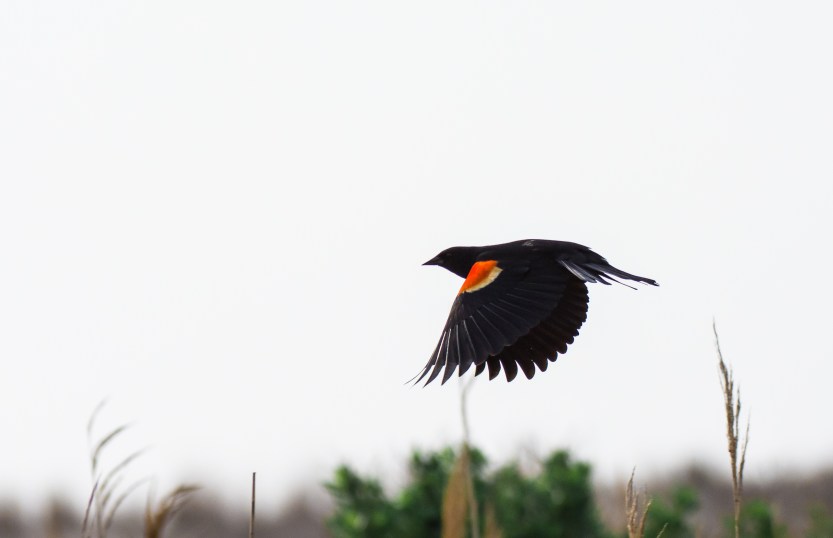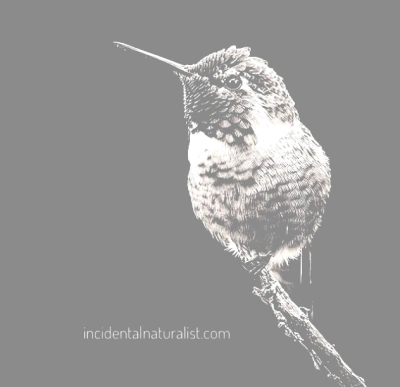If you are reading this in the United States of America, you might be wondering what is so special about the common or garden Red-winged blackbird. This is one of the most numerous birds in the country, with a population estimate of around 190 million across the North American continent. Widespread, the Red-winged blackbird can be found breeding in every state in the United States of America, except for Hawaii.
I may have lived in the USA for three years, but I still feel delight every time I see this boring old bird flit by. My first encounter with the Red-winged blackbird was a lone male along the banks of the Chicago River. It was clearly a magnificent little bird, but it wasn’t until I made a trip to Cape May, New Jersey that I really fell in love with these feisty little show-offs. I parked the car at Cape May lighthouse, and walked the path that snakes between the lake and sand dunes, that role down to the Atlantic Ocean. I followed the track on to a meandering boardwalk that snakes through vast reed beds. For most birders, the Cape May star attractions are the migrating hawks, high up in the sky, or the water fowl, drifting on the surface of lake, or ocean. I was enthralled by the show that occurs in the middle band at the top of the reed line, where Red-winged blackbirds stake their claim to territory, with dance and songs.

For the male Red-winged blackbird territory is everything, for it is in this claimed patch of reeds that he establishes his hareem. He makes, and maintains his claim to an area by perching on the highest, most visible twig or reed, where he blasts out his song. This song is accompanied by a flamboyant dance, choreographed to illuminate the stage with his fiery epaulettes. He will aggressively defend this territory from all comers, be that love rivals, other bird species or even people.


A strong male with a high quality territory can enjoy a hareem of up to 15 females. Each female will weave a grassy nest low to the ground, where she will lay up to 4 eggs. Simple math tells us that our male may sire 120 young for the first brood, and by the end of the summer, up to 240 young. But all is not as it seems. While enjoying the hospitality of the hareem, the female, like her father, is not inclined to remain faithful, often seeking the company of the guy next door. It is estimated that up to half of the young that fledge from a hareem have been fathered by a male that is not the governor of the territory. This is despite the fact that the male makes regular fly-bys over his land, flashing his epaulettes, in full song, to ensure that there can be no mistaking who owns the patch.


The first time I spotted a female of the species I snapped a photograph, and dived into my bird field guides in search of this new species that I had discovered. Was it a sparrow? Maybe a bunting? The female is so different from the male that a novice blackbirder could not hope to make a positive identification. She may be sparrow brown with stripes and flecks, but she is also a beautiful, robust, and feisty lady.


As we might expect, the conservation status of the Red-winged blackbird is listed as Least Concern, but as is so often the case, this status does not tell the complete story. Since 1966 the species has seen a decline in population size by over 30%. It is unclear what it is driving this decline, but I’m certain that the continued loss of wetland habitat, our determination to kill off all insects, and climate uncertainty are playing a role.
In America, over a third of all species recorded on the US Endangered Species list live in wetlands, with half of the same list spending a portion of their life tied to wetlands. The continued loss of this vital habitat will see further decline of the Red-winged blackbird, as well as countless other creatures of land, air and sea.

It was not until I got home and looked through my photographs that I noticed that some of the birds I photographed have rings on their legs. It makes me happy to know that someone if looking out for the future of these beautiful, engaging little birds. If you get a chance, sit and watch a colony of Red-winged blackbirds going about their business on a spring morning. You will never look at them in the same way again.
If you find a banded (wearing a ring) bird, be it a Red-winged blackbird or any other North American species, be sure to report it to the Bird Banding Laboratory
If you enjoyed this post, please follow Incidental Naturalist.
Comments below are welcomed.
Help others to connect with wildlife experiences by sharing this post on social media.
Categories: USA




I may have said this before, but I spent many years working in a restore wetland in the Eastern United States. So I consider red-winged blackbirds to be old friends, and not at all boring. They are beautiful birds, and I’m glad you enjoyed watching them!
LikeLiked by 2 people
Thanks for the comment, Josh and thanks for the service you gave to our wetlands.
LikeLiked by 1 person
No problem, David. And the job itself was thanks enough; I often wonder why I ever left it.
LikeLiked by 1 person
Because if you had stayed you might miss later opportunities to work with big cats 😊
LikeLiked by 1 person
Very true!
LikeLike
Wonderful photographs David. I’ve seen many red wing blackbirds up here in Canada, in the wetlands near the coast, but have not been able yet to capture a decent shot.
Alison
LikeLiked by 1 person
Thanks Alison! I think they are one of those birds that most people do not go out to photograph. I certainly didn’t plan to, but got a little fortunate on the day.
LikeLiked by 1 person
This little soldier was one of the first birds I learned to identify. His flashy epaulettes and big personality make him easy to identify. I love them too. I used to look for them on the drive between New Jersey & New York. The meadowlands between was used as a garbage dump for decades, the water was further poisoned with DDT runoff. It was a dead zone. Then things began to change. Thanks to folks like Rachael Carson, people started to become more ecologically aware. DDT was outlawed. The dumping slowed. It took decades but the birds began to come back, the first was feisty Red-Winged Blackbird!
LikeLiked by 1 person
Hi Roberta! Thanks for the fabulous comment, that really adds a little something to my article. Hopefully it will encourage people to read about the work of Rachael Carson, and learn about the movement that she started. I have heard much about the Meadowlands (usually in the same breath as the Sopranos) but it is great to hear how it has come back to life for the local wildlife.
LikeLike
You have a lovely nature ; photography and posts 😇💖
LikeLiked by 1 person
Love this post! I knew nothing about the red-winged blackbird before this, but now I feel inspired to write about one. Nice job, David!
LikeLiked by 1 person
Thanks for the very kind words! 🙂
LikeLike
Hey there! I can see that you put some effort on your blog. You have a very high quality content. You seem like a successful blogger and I would like to make you one or two questions if you have the time, about blogging! Let me know. Keep it man!!
LikeLiked by 1 person
Thanks for your kind words, Phil! You flatter me a little, but if you have some questions that you believe I could help with please feel free to drop me a note through the contact page. Cheers!
LikeLiked by 1 person
Thank you my friend. I will. Thank you for your time.
LikeLike
I love the up-close, clear pictures! And would never have guessed the female has such markings – very pretty, actually! Wonderful to learn about and appreciate the things we often see, but take for granted as “common.” So much beauty to be discovered when you give time, attention, and appreciation to any given thing in life. Thank you, David!
LikeLiked by 1 person
Hi Lara! Good to hear from you. Thanks again for the kind words. She is beauty isn’t she? You’re right, when we care to take the time to look and really see, the world can be a remarkable place 😊💚
LikeLiked by 1 person
Cheers to that, David “))
LikeLiked by 1 person
Fabulous photos, David! So you only post once a month??
LikeLiked by 1 person
Thanks Susie! I started by posting once a week, but am currently in a once a month cycle. The reason for this being that I am in a moment in life where I can’t get out on quite so many adventures to wild places. I hope to get back to weekly, or at least fortnightly at some stage.
LikeLiked by 1 person
I love the Red-winged blackbird photos! They certainly don’t appear in my Motherland (England) and haven’t seen them where I live in Switzerland either. Thanks for sharing! I have a poetry blog here on WordPress and today’s poem features a blackbird in case you have time to look? Have a relaxing weekend, Sam 🙂
LikeLiked by 1 person
Thanks for the comment! These guys are primarily in North America. My Motherland is also England where the blackbird is baked in a pie by the four and twenty! I’ll stop by your blog later. Have a good one!
LikeLiked by 1 person
You too and thanks! 🙂
LikeLiked by 1 person
Thank you for sharing your passion; I’m glad you didn’t stick to your regular job alone.:) As a point and shoot iPhone photographer I have no hope of capturing those birds, let alone in such fine detail. Your images are excellent but I also enjoy the stories of your encounters and information about the birds. I will follow you.
LikeLiked by 1 person
Thank you for your kind words, Mary. Welcome to my blog! I’ll look st yours in a little more detail later. Looks good! I’ve recently bought a couple of clip-on Moment lenses (macro and wide) for my IPhone. They are hand to have in your pocket for flowers, food or scenery and add a little something extra to point and shoot. I do that, too! ☺️
LikeLiked by 1 person
Thank you, David for the tip! I have not heard of such things 🙂 Will google 🙂
LikeLike
I grew up in Manitoba, Canada and I love them too. They mean spring has arrived!
LikeLiked by 1 person
Not reading from USA. They are aesthetically gorgeous on top of the vibrant contrasts. Your pictures are captured beautifully. I get a sense of serenity in them. Thank you for sharing 🌼
LikeLiked by 1 person
Thank you so much for the kind and encouraging comment. There is certainly serenity unless there is a territory to defend 😊
LikeLike